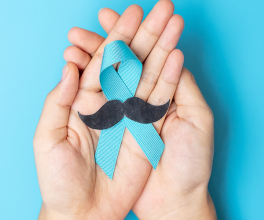
COPD Awareness Month: Take a Breath, Take Control
“It’s funny, but you never really think much about breathing. Until it’s all you ever think about.”
Lamaze breathing is a traditional method taught for childbirth.1 Pranayama is breathwork practiced during yoga.2 Breathing exercises are also employed as a method to manage anxiety and stress.3 In each instance, the prevailing theme is control. But people with chronic obstructive pulmonary disease (COPD) who experience shortness of breath, coughing, wheezing, and chest tightness may feel a loss of control over respiratory symptoms that impact daily life.4,5 To that end, November is COPD Awareness Month, a time to encourage people with these symptoms to reach out for help, and take back control while it’s still possible.
The COPD landscape
COPD is an umbrella term that includes emphysema and chronic bronchitis. An estimated 15 million U.S. adults have been diagnosed with COPD—more than half are women—but millions more may have the condition without realizing it.4 COPD is a major cause of disability and the fourth leading cause of death in the U.S.4
The distinctions between emphysema and chronic bronchitis are subtle, and most people have a combination of both:5
• Emphysema—Walls of the air sacs in the lungs are destroyed and the air sacs lose shape.
• Chronic bronchitis—Airway lining in the lungs becomes swollen and inflamed and excess mucus is produced.
‘Try breathing through a straw’
When COPD symptoms are mild, people may adjust routines by taking the elevator instead of the stairs, or resting more often during an activity, chalking symptoms up to aging or being out of shape, according to Lisa Postow, Ph.D., Program Officer, Division of Lung Diseases, NHLBI.5
The easiest way to understand how someone with COPD feels is to “try breathing through a straw,” Postow said in a video posted on the NHLBI COPD page.5 COPD has also been linked to increased confusion, memory loss, and functional limitations, the latter including an inability to work, loss of engagement in social activities, and neglecting household chores. It is also tied to increased hospitalizations.6
COPD management options
COPD can usually be diagnosed with a noninvasive spirometry test to measure lung function.7 Diagnosis is the first step to earlier treatment, which will not cure the disease, but may open the door to therapies and interventions to manage symptoms. The following are NHLBI recommendations, which can vary based on disease progression and other factors:
If you smoke, quit. Smoking is the leading cause of COPD. However, it should be noted that up to 30% of people diagnosed have never smoked. In addition to environmental factors, a rare condition known as alpha-1 antitrypsin deficiency can also cause COPD.8
Prescription drugs. Medicines include bronchodilators or a combination of bronchodilators and steroids. Sometimes an inhaler is prescribed to deliver these medications.8
Pulmonary rehab. A supervised program can include exercise training, health educators, and breathing techniques for people with certain lung conditions.8
Oxygen therapy. Oxygen therapy is used when blood oxygen levels are too low. Oxygen delivery is delivered in several ways; from tubes in the nose, a face mask, or a tube placed in the trachea (windpipe). Oxygen therapy can be delivered in the hospital or at home.8
Surgery. Surgical interventions are a consideration for severe COPD cases. These procedures can include:8
- Bullectomy—removal of one or more very large bullae from the lungs. Bullae are larger air spaces that form when walls of the air sacs are destroyed.8
- One-way endobronchial valves—these valves can be implanted in the bronchial tube, allowing air to exit damaged parts of the lung, but not to re-enter it.8 Olympus® SpirationTM Valve System is an example of this intervention, featuring umbrella-shaped valves designed for minimally invasive bronchoscopic lung volume reduction in patients with severe emphysema.9
- Lung volume reduction therapy—removes damaged tissue from the lungs and helps lungs to work better.8
Lung transplant. A lung transplant may be an option for severe or advanced cases that do not respond to other therapies. Surgery is performed to remove a diseased lung and replace it with a healthy donor lung. Lifetime antirejection medications are typically prescribed to suppress the immune system, along with healthy lifestyle adoption support recommendations.8
Keep in mind that it is important to talk to a physician about the benefits and risks associated with any of these interventions and procedures.
Potential complications which may be associated with the use of the SpirationTM Valve System may include, but are not limited to, pneumothorax, worsening of COPD symptoms, pneumonia, and dyspnea. Prior to using the Spiration Valve System, please review the full list of prescriptive information at https://spirationvalve.com/potential-risks-complications for additional information on indications, contraindications, warnings, precautions and potential complications.
Taking back control
If you or a loved one experiences symptoms of COPD, consider scheduling a screening with your doctor. The following resources may help to put you on the path toward regaining control in your daily life.
Learn more about COPD next steps
Find more information about COPD at the American Lung Association. Visit here.
Get resources form the NIH’s Learn More Breath Better® program. Visit here.
Ready to quit? Call the National Cancer Institute’s Smoking Quitline at (877) 44U-QUIT or visit here.
References
1. Lothian JA. Lamaze breathing: what every pregnant woman needs to know. J Perinat Educ. 2011 Spring;20(2):118-20.
2. YogaJournal.com. What is Pranayama? Published July 25, 2022. Accessed September 20, 2023.
3. HarvardHealth.edu. Relaxation techniques: Breath control helps quell errant stress response. Published July 6, 2020. Accessed September 20, 2023.
4. CDC.gov. Basics About COPD. Updated June 30, 2023. Accessed September 18, 2023.
5. NHLBI.NIH.gov. What is COPD? Updated March 24, 2022. Accessed September 19, 2023.
6. Greenlund KJ, Liu Y, Deokar AJ, et al. Association of chronic obstructive pulmonary disease with increased confusion or memory loss and functional limitations among adults in 21 States, 2011 Behavioral Risk Factor Surveillance System. Prev Chronic Dis. 2016 Jan 7;13:E02.
7. Lung.org. Spirometry. Updated March 10, 2023. Accessed September 21, 2023.
8. NHLBI.NIH.gov. COPD Treatment. Updated March 24, 2022. Accessed September 19, 2023.
9. Data on file with Gyrus ACMI, 2018.





